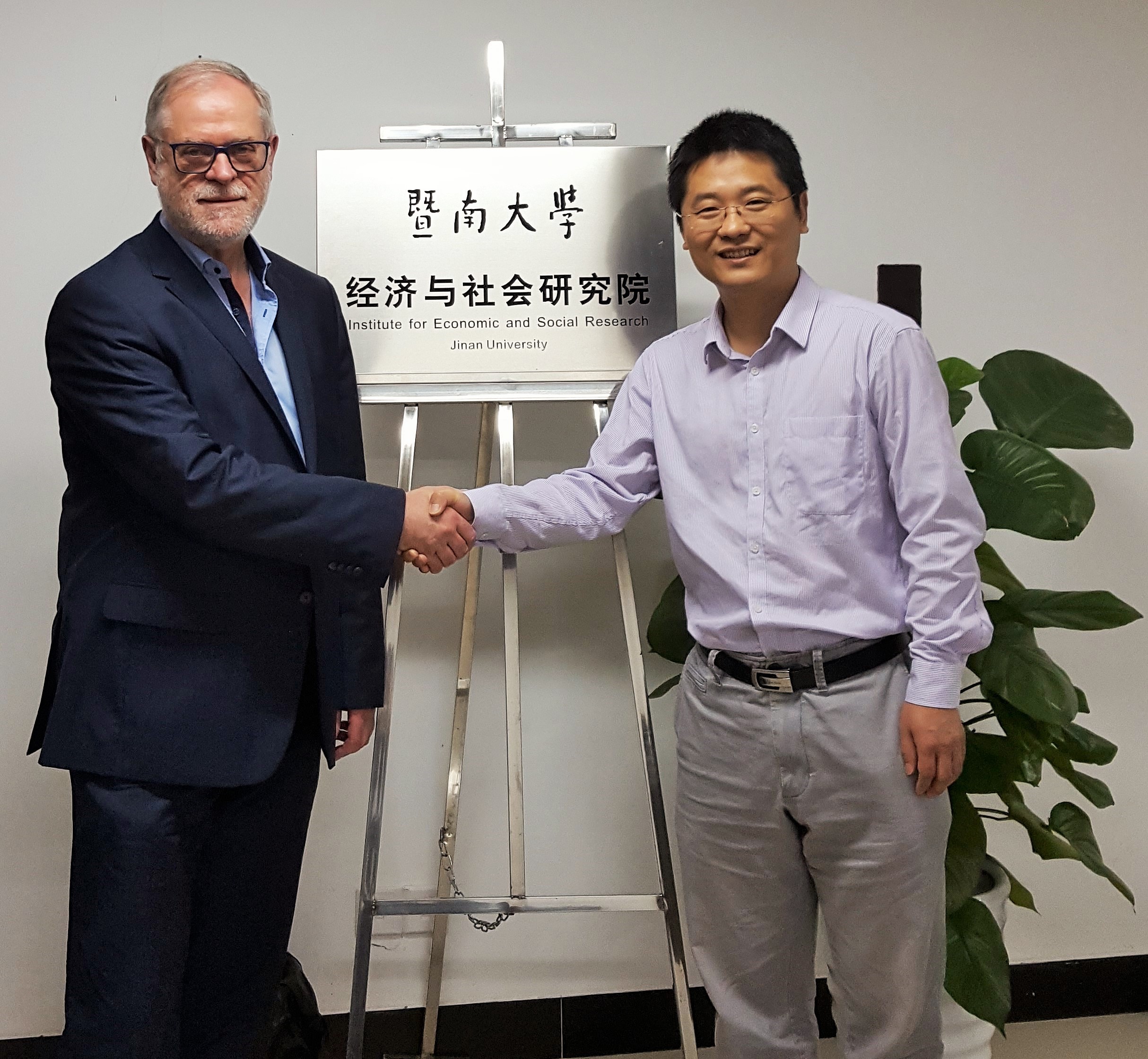How to measure, analyze and fight long-term unemployment in China and Europe? Labor market experts Shuaizhang Feng (Jinan University) and Klaus F. Zimmermann (UNU-MERIT, Maastricht) discussed this in Guangzhou/China on March 19, 2018.
On the invitation of Professor and Dean Shuaizhang Feng, Head of the Institute for Economic and Social Research (IESR), the President of the Global Labor Organization (GLO), Klaus F. Zimmermann (UNU-MERIT, Maastricht), visited Jinan University in Guangzhou/China from March 11 to March 20. Together with GLO Fellow Feng, he has organized a joint IESR – GLO Labor Workshop that took place at Jinan University on March 13, 2018.
On March 19, Shuaizhang Feng and Klaus F. Zimmermann had a more than two hours dialogue discussing labor market challenges and policies in China and Europe. They talked about similar unemployment problems, exploring underlying causes of the high long-term unemployment rates, and the consequences and policies to address these issues.
Chinese – European dialogue in Guangzhou/China on March 19, 2018: Shuaizhang Feng (right) and Klaus F. Zimmermann

Source: https://iesr.jnu.edu.cn/#/EnWeb/News/NewsDetail?id=2019&nid=5&cid=2
China (following Feng et al., 2017): “Unemployment rates in countries across the world are strongly correlated with GDP. China is an unusual outlier from the pattern, whose official government statistics show abnormally low, and suspiciously stable, unemployment rates relative to its GDP….. Estimates of China’s unemployment rate for its local urban Hukou population using a more reliable, nationally representative dataset for that population than in prior work…. show unemployment rates …” that “…differ dramatically from those supplied in official data and are much more consistent with what is known about key historical developments in China’s labor market. The rate averaged 3.7% in 1988–1995, when the labor market was highly regulated and dominated by state-owned enterprises, but rose sharply during the period of mass layoff from 1995 to 2002, reaching an average of 9.5% in the subperiod from 2002 to 2009.” Researchers work on more transparent regular statistics which will help to improve employment policies.
Europe: In early 2018 (January), Europe exhibits high unemployment rates (European Union: 7.3%; Euro Area 8.6%) with a large variance (e.g., Greece 21%; Spain 16%; Romania 4.6%; Germany 3.6%) following the slow recovery after the worldwide 2008 recession. European markets were largely stagnating with youth unemployment traditionally twice as large as general unemployment. An exception has been Germany which has demonstrated that structural unemployment can be reduced through labor market reforms. Cross-country variations of long-term unemployment are characterized by skills mismatch, inflexibility, lack of education and compensating differentials. Solutions include youth vocational training, flexible management of working time in crisis periods (short-time work, time accounts, labor hording), social cohesion, controlled unit labor costs, incentive-oriented labor policies and effective program evaluation.
Literature:
Shuaizhang Feng, Yingyao Hu & Robert Moffitt: Long run trends in unemployment and labor force participation in urban China, Journal of Comparative Economics, 45 (2017) 304–324.
Shuaizhang Fengy & Naijia Guo: Labor Market Dynamics in Urban China and the Role of the State Sector, (2018), Jinan University, mimeo.
Jo Ritzen & Klaus F. Zimmermann: Towards a European full employment policy, UNU-MERIT Discussion Paper #2018-018.
Ulf Rinne & Klaus F. Zimmermann: Is Germany the North Star of Labor Market Policy?, IMF Economic Review, 61 (2013), 702-729.
| Pierre Cahuc Stéphane Carcillo Ulf Rinne Klaus F. Zimmermann |
Youth Unemployment in Old Europe: The Polar Cases of France and Germany IZA Journal of European Labor Studies, 2:18 (2013) |
THANKS FOR THE DEBATE AND A GREAT VISIT:

Ends;


